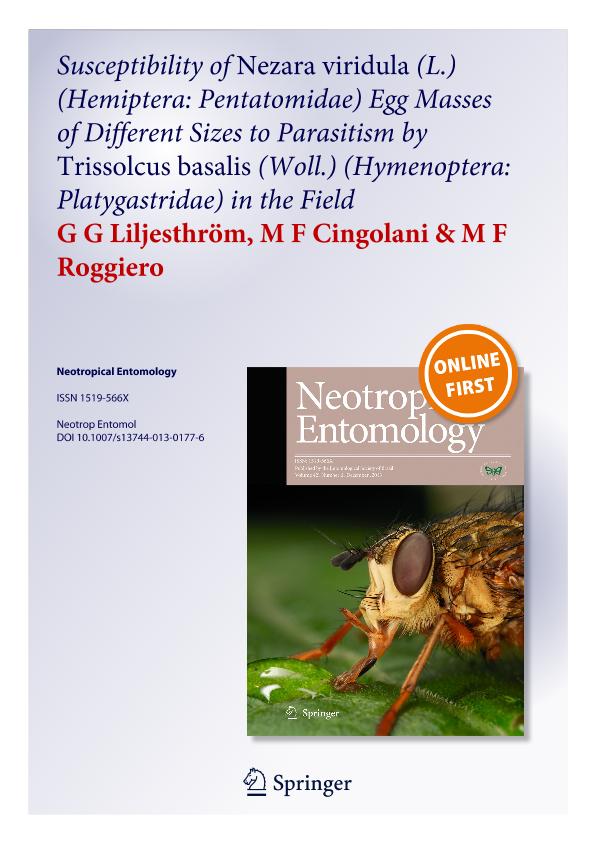Artículo
Susceptibility of Nezara Viridula (L.) (Hemiptera: Pentatomidae) egg masses of different sizes to parasitism by Trissolcus Basalis (Woll.) (Hymenoptera: Platygastridae) in the field
Fecha de publicación:
11/2013
Editorial:
Sociedade Entomológica Do Brasil
Revista:
Neotropical Entomology
ISSN:
1519-566X
e-ISSN:
1678-8052
Idioma:
Inglés
Tipo de recurso:
Artículo publicado
Clasificación temática:
Resumen
Egg masses of Nezara viridula (L.) are commonly parasitized by Trissolcus basalis (Woll.), and we investigated the role of size of egg masses on parasitization by T. basalis. Sentinel egg masses were exposed to parasitism in the field for 6–7 days, when they were collected for evaluation of parasitoid emergence. We recorded the number of eggs per egg mass, the number of emerged hosts, and the number of empty and parasitized eggs. We calculated the proportion of attacked host egg masses (DE), the proportion of parasitized eggs per attacked egg mass (PE), and total parasitism (PI). The total number of egg masses exposed to parasitism was 330. The minimum, mean, and maximum egg mass sizes were 25, 75.2, and 111, respectively. DE and PE varied widely between different fields, and they were independent of egg mass size. In 14.2% of all parasitized egg masses, we found simultaneous emergence of T. basalis and N. viridula independently of host egg mass size. PE exhibited low variability compared with PI and DE, which were linearly related. PI and DE values from other field studies are consistent with the linear relationship, suggesting that PI is mostly related to the proportion of the DE. This also suggests that total parasitism is independent of egg mass size, of possible differences in plant species, and T. basalis density and strains.
Palabras clave:
Stink Bug
,
Egg Mass Size
,
Egg Parasitoids
,
Field Parasitism
Archivos asociados
Licencia
Identificadores
Colecciones
Articulos(CEPAVE)
Articulos de CENTRO DE EST.PARASITOL.Y DE VECTORES (I)
Articulos de CENTRO DE EST.PARASITOL.Y DE VECTORES (I)
Citación
Liljesthrom, Gerardo Gustavo; Cingolani, Maria Fernanda; Roggiero, Martha Florencia; Susceptibility of Nezara Viridula (L.) (Hemiptera: Pentatomidae) egg masses of different sizes to parasitism by Trissolcus Basalis (Woll.) (Hymenoptera: Platygastridae) in the field; Sociedade Entomológica Do Brasil; Neotropical Entomology; 43; 11-2013; 78-84
Compartir
Altmétricas




